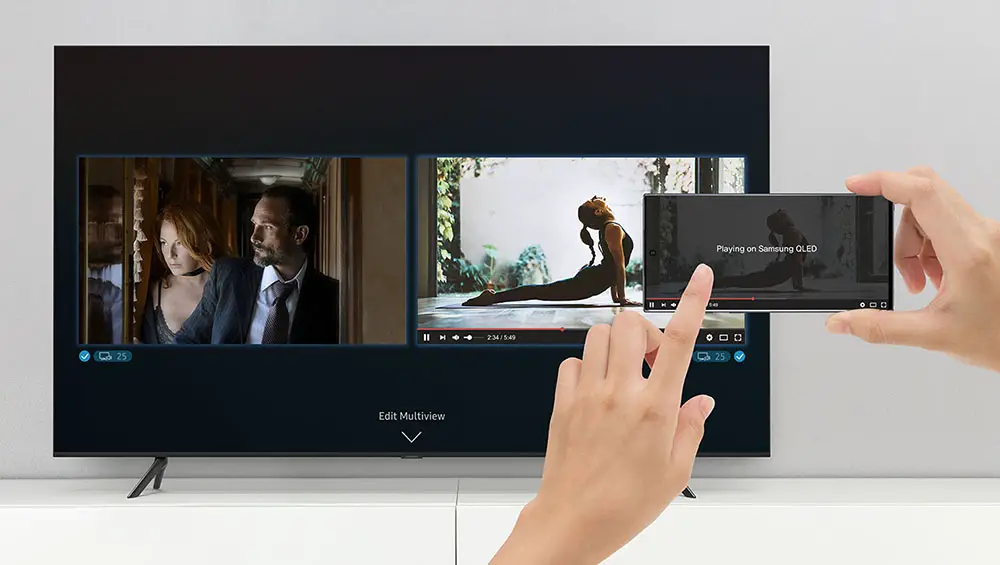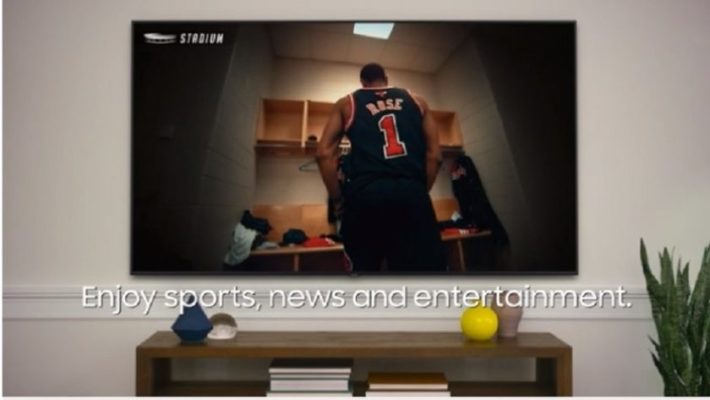Ask more from your TV. Just ask Alexa to open apps, change the channel, search for movies and shows , play music, control your smart home devices and more. To talk to Alexa, press and hold the mic button on your remote. If you have hands-free enabled just say, “Alexa” and ask a question. View your favorite content at four times the resolution of 1080p with the Samsung 85-inch class QLED Q80T series. This TV has an 84.5″ Quantum Dot LCD panel to produce vibrant color and incorporates Motion Rate 240 technology to digitally enhance fast-moving images to reduce blur. It is compatible with the HDR10, HDR10+, and HLG HDR formats to provide a wider color gamut with compatible content and other equipment for more vivid images. FreeSync variable refresh rate technology helps enhance your video game experience by reducing tearing and stuttering. Details covered in Samsung 85-inch class QLED Q80T series review.
What is the differences between Samsung 85-inch class QLED Q80T series and Q70T series?
But the Q80T has a lot going for it and we find a couple of major differences compared to the lower Q70T. First of all it’s the most affordable QLED with a Full Array with Local Dimming (FALD) backlight system. Anything below the Q80T uses an Edge LED, or Dual LED as Samsung likes to call it, light system so if you are in the market for a FALD TV then this is the most cost friendly offering by Samsung. The second major difference with the lower tier models is that the Q80T uses a newly designed audio system called Object Tracking Sound which we will analyze in the appropriate section.
Everything else seems to be the standard as the Q80T uses a VA panel as per usual, it has Samsung’s Quantum Dot technology for better and more vibrant colors, it comes with Quantum Processor 4K that offers AI image and audio enhancements and features the latest version of Tizen smart TV platform with all its functionality and online features. Oh, and we should not forget to mention the inclusion of HDMI 2.1 which was a bit surprising considering that Samsung had initially announced that only their 8K TVs would get it. So with all it has to offer, does the Q80T manages to be a competitive model in it’s category and what you should expect from Samsung’s most budget friendly FALD TV set? Keep reading to find out.
Specifications – Samsung 85-inch class QLED Q80T series
Type: QLED 4K TV
Series: QLED Q80 Series
Design: Boundless Design
Color: TITAN BLACK
Stand Type (Color): FLOATING PLATE
Screen Size: 84.5″ Measured Diagonally
Resolution: 3,840 x 2,160
Motion Rate: 240
Color: 100% Color Volume with Quantum Dot
HDR (High-Dynamic Range): Quantum HDR 12x
Picture Engine: Quantum Processor 4K
Quantum Dot Color: Yes
Dolby: Yes
Sound Output (RMS): 60W
Woofer: Yes
Speaker Type: 2.2.2CH
Multiroom Link: Yes
Bluetooth Headset Support: Yes
Wi-Fi Connectivity: Yes (802.11ac)
Wi-Fi Direct: Yes
Bluetooth: Yes (ver.4.2)
Smart Hub: Yes (incl. Universal Guide and TV Plus)
Processor: Quantum Processor 4K
Apps Platform: Smart TV Powered by TIZEN™ with Bixby Voice, Apps and Full Web Browser
Bixby: Yes
Works with Google Assistant: Yes
Works with Alexa: Yes
Digital Clean View: Yes
Ultra Black: Yes
Game Mode: Yes (Real Game Enhancer+)
Ambient Mode: Yes (Ambient Mode+)
USB HID Support: Yes
Eco Sensor: Yes
TV to Mobile – Mirroring: Yes
Mobile to TV – Mirroring, DLNA: Yes
HDMI: 4
USB: 2
Ethernet (LAN): Yes
RF In (Terrestrial/Cable Input): 1/1(Common Use for Terrestrial)/0
RF In (Satellite Input): 1/1(Common Use for Terrestrial)/0
Digital Audio Out (Optical): 1
Audio Return Channel Support (via HDMI port): Yes
RS232C: 1
Dimension
Product Size (W x H x D) Without Stand:74.5″ x 42.6″ x 2.2″
Product Size (W x H x D) With Stand: 74.5″ x 45.8″ x 13.3″
Stand Size (WxHxD): 16.5″ x 10.5″ x 13.3″
Shipping Size (W x H x D): 84.5″ x 49″ x 10.2″
Product Weight Without Stand: 95.5 lb.
Product Weight With Stand: 110.5 lb.
Shipping Weight:144.6 lb.
Power Supply (V): AC110-120V 50/60Hz
Typical Power Consumption: 154
Maximum Power Consumption: 470
Standby Power Consumption: 0.5
DTV Tuner: ATSC/ClearQAM
Digital Broadcasting: ATSC/ClearQAM
Analog Tuner: Yes
Vesa Wall Mount Compatibility: Yes
Remote: TM2050C
Remote Control Battery: Yes
Power Cable: Yes
User Manual: Yes
E-Manual: Yes
Smart TV
Quantum Dot Color: Yes
Flat TV: Yes
Smart TV: Yes
4K UHD Resolution: Yes
HDR: Yes
Key features – Samsung 85-inch class QLED Q80T series
Quantum Dot Technology with a 4K Processor
Quantum Dot technology is designed to provide over a billion colors, and the onboard 4K processor upscales images for enhanced clarity.
Direct Full Array 12X
The backlights are engineered to intelligently adjust to help provide richer black levels for augmented contrast.
Quantum Processor 4K
The onboard processor helps optimize the picture to deliver a more immersive experience.
4K AI Upscaling
This technology analyzes the input source to reduce image noise, restore lost detail, and add definition to the edges around objects and text.
Adaptive Picture
Whether in a sunlit living room or a darkened den, Adaptive Picture technology optimizes the TV by analyzing the picture and the room’s lighting conditions for augmented images, wherever and wherever you watch.
Object Tracking Sound
With dedicated up-firing and down-firing speakers, the audio can track every motion on the screen to create a more realistic 3D sound experience.
Quantum HDR 12X with HDR10+
Quantum HDR 12X is designed to bring out detail and contrast by expanding the range of color and detail beyond what’s possible on non-HDR TVs. The dynamic tone mapping of HDR10+ creates deeper blacks and more vibrant imagery with compatible content and source devices.
100% Color Volume with Quantum Dot
With 100% color volume (in the DCI-P3 color space), the Q80T is engineered to provide lifelike images without washing out at any brightness level.
Real Game Enhancer+
With this technology, extra motion clarity automatically reduces halo and blur in fast-moving game scenes, and AMD FreeSync helps reduce tearing and stuttering.
Motion Rate 240
This image enhancement technology helps minimize motion blur on the screen, so your action-packed movies and sports stay smooth.
Ultra Viewing Angle
The TV is designed to reduce glare and enhance color, providing vibrant images from nearly any viewing angle.
Active Voice Amplifier
Active Voice Amplifier technology is designed to analyze the ambient noise in your home and enhance the voices in the scene to help you hear dialogue clearly.
Boundless Design
The thin bezel and minimalist design of the TV helps draw you into your content.
Ambient Mode+
This mode is designed to allow the TV to mimic the wall behind it display décor, artwork, weather reports, the day’s headlines, and more.
OneRemote for Your Connected Devices
The included OneRemote can automatically detect and control all compatible connected devices and content.
Universal Guide
The universal guide brings your favorite content from multiple compatible devices and apps together in one easy-to-browse menu. It recommends popular shows and can make custom recommendations tailored just for you.
Multi View
This feature splits your TV screen in two, putting the content you’re watching on one side while mirroring your compatible mobile device on the other, allowing you to watch workout videos, check sports stats, and more while watching your favorite show or game.
Choose Your Voice Assistant
With both Bixby and Amazon Alexa built-in, you can access your favorite content, get answers, and control the TV and other compatible connected devices around your home with just your voice.
SmartThings Compatibility
The Q80T TV works with SmartThings to put you in control of your compatible smart home devices. It links with IoT devices and sensors, enabling you to turn on the lights, check what’s inside your refrigerator, and run the robot vacuum cleaner from the comfort of your couch.
Q-Symphony
The speakers in the Q80T are engineered to work alongside your Samsung Q series soundbar to produce an augmented surround sound experience.
TV Plus
TV Plus lets you enjoy your favorite content through virtual channels.
HDMI Connectivity
Enjoy high-resolution audio and video with an HDMI connection that transmits both over a single cable. The onboard HDMI ports support 4K UHD and HDR content decoding. Input 4 supports HDMI 2.1, and input 3 is eARC-compatible.
Integrated Wi-Fi 5
Enjoy your favorite on-demand content wirelessly via your existing network.
Dolby Digital Plus
This audio technology helps optimize your entertainment experience with enhanced sound richness and clarity.
CTA 4K UHD Connected
The Q80T complies with the Consumer Technology Association (CTA) 4K Ultra High-Definition Connected definition requirements.
Samsung 85-inch class QLED Q80T series comparison
| Q80T | Q900TS | Q90T | Q70T | |
| Screen Size | 85″, 75″, 65″, 55″, 49″ | 85″, 75″, 65″ | 85″, 75″, 65″, 55″ | 85″, 82, 75″, 65″, 55″ |
| Alexa Built-in | ✔ | ✔ | ✔ | ✔ |
| Resolution & Design | 4K UHD with Boundless Design | Real 8K with Infinity Screen | 4K UHD with Boundless Design | 4K UHD with Boundless Design |
| Upscaling | 4K AI Upscaling | 8K AI Upscaling | 4K AI Upscaling | 4K AI Upscaling |
| Processor | Quantum Processor 4K | Quantum Processor 8K | Quantum Processor 4K | Quantum Processor 4K |
| Back Light | Up to Direct Full Array 12X⁹ | Direct Full Array 32X | Up to Direct Full Array 20X⁹ | Dual LED |
| HDR | Quantum HDR 12X | Up to Quantum HDR 32X⁹ | Quantum HDR 16X | Quantum HDR |
| Viewing Angle | Ultra Viewing Angle | Ultra Viewing Angle | Ultra Viewing Angle | Wide Viewing Angle |
| Motion Rate | 240¹⁰ | 240 | 240 | 240 |
| Audio | Object Tracking Sound | Object Tracking Sound + | Object Tracking Sound | Active Voice Amplifier |
Samsung 85-inch class QLED Q80T series review
Design
As for it’s general looks and design the Q80T is a really nice TV featuring a boundless design in all four sides which gives a more premium feel to it with very thin borders giving the image a more pronounced look. The TV’s overall thickness is very good although slightly thicker than the Q70T as it has the FALD system at the back which adds a bit of depth. But overall it is a very thin TV for being a FLAD one and will definitely look nice if you plan to wall mount it.
If you expect to find the amazing One Connect Box you will be disappointed to know that Samsung decided to use this only for two models in 2020. Their top 8K flagship Q950TS and the European only top 4K QLED, the Q95T. It’s amazing that in the US Samsung doesn’t have a single 4K TV that uses the One Connect Box and it feels like they try to phase it out slowly rather than use it in more of their models as we were hoping a few years ago when they started using it.
The back side features a similar design to the one we saw in the Q70T with a dotted design covering most of it’s surface. All ports are grouped together on the left side on a special inset with sideways orientation that can definitely help with cable management if you want to place in on a wall. On the right side we only find the power connector while on the bottom we get special grooves in order to drive the cables to the central stand. Lastly we get holes for the VESA wall mount.
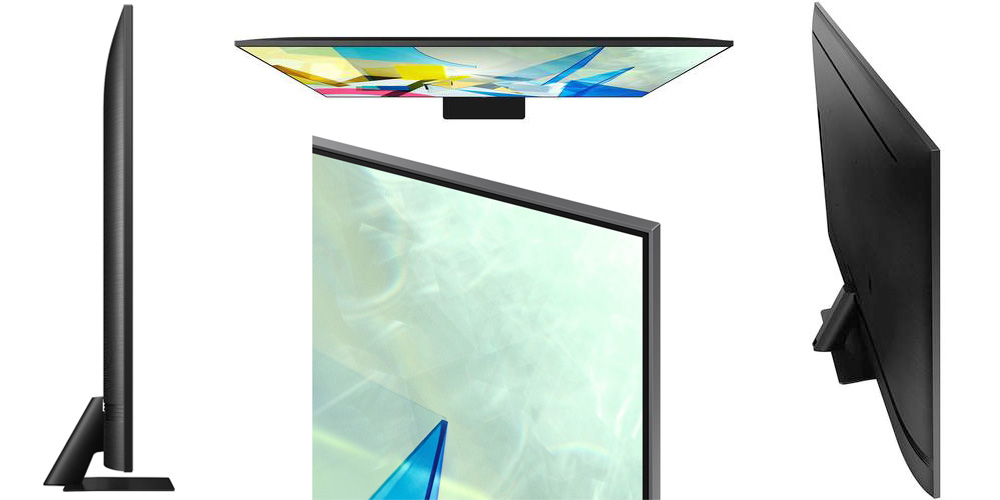
Stand
Let’s talk a bit about the stand as the Q80T uses a pedestal-style stand which looks pretty nice and is small enough so you can place the TV even on small furniture. Obviously this kind of stand can cause the TV to wobble a little but is stable enough not to cause any trouble. The stand is using both plastic and metal and with it’s flat surface makes installation of a soundbar far easier than some other stands we have seen from Samsung recently. The back of the stand is hollow so you can pass the cables through it for a cleaner look.
Remote
The remote that comes with the Q80T is exactly the same we saw in both the Q70T and Q60T and is the usual One Remote with the standard gun-metal black arch back design. As we had mentioned in our previous reviews the design is exactly the same as last year with the only change being the Hulu dedicated button being replaced with Samsung TV plus.
Everything else is completely the same with the One Remote coming with a built-in microphone that you can use to issue commands to the various voice platforms the TV has built-in. If your other devices have HDMI-CEC then the remote can act as a universal remote also but Samsung took this one step further as it can also control other devices even without having the required HDMI-CEC functionality. We were always fond of Samsung’s approach to their remotes and the One Remote shows that they are happy with the design they have and in all honesty so are we. It’s obvious that they rely more on the TV’s UI instead of fighting with the remote’s buttons and we believe this is the way to go.

In total we can say that the Q80T does feel like a premium model. Very nice four sides boundless design, great central stand and good materials used along with a remote that is at the top spots of our favorite remotes the last few years makes this an overall great looking TV.
Smart TV (Tizen)
Samsung has made some revisions to its Tizen smart TV platform this year to improve usability. The launcher bar is a little smaller, allowing more apps to sit onscreen without a need to scroll. When viewed on the larger Q80T models, this makes perfect sense. There’s also enhanced connected device discovery, making it easier to jump between inputs.
Also new this season is Mobile Multi View with Casting, which enables two screens (the main TV image and your smartphone) to be watched simultaneously.
While there’s no Freeview Play tuner (on the UK edition of the set), all key Catch-up TV channels are supported, along with Netflix, Amazon Prime Video, Disney Plus, Rakuten TV, Apple TV and YouTube (to name but a few).
Samsung’s Ambient mode also makes a welcome return, allowing the QLED screen to serve as a gallery for JPEGs or artworks, or double as a news ticker or clock.
Smart TV TL;DR: Overflowing with bingeable streaming apps, and bolstered by Ambient Mode, this slightly smarter QLED ticks all the right boxes. Newcomer Multi View Mode with casting will probably have limited appeal, but for YouTube tutorial addicts and Twitch gamers, it’s undeniably useful.
Video Quality – Samsung 85-inch class QLED Q80T series review
Lighting technology used
If there is one characteristic that can drastically change the image quality of these QLEDs is the type of backlight system they use. For 2020 it seems that Samsung have used the better Full Array with Local Dimming (FALD) backlight system in their Q90T and Q80T models while the Q70T and Q60T had to settle for the inferior Dual LED system.
A FALD system in order to perform good depends on two factors, the number of dimming zones available and how fast each zone can change it’s light output. The more dimming zones used the better and more accurate light control the TV has but also the higher the price goes, that’s why they usually scale the dimming zones number depending on the model. The effect on having low number of dimming zones can be seen when you see a very bright object on a completely dark background. If the TV has very few zones light will escape to the nearby pixels and create a visible halo around the object.
Also the light algorithms play a huge role as they control the response time of the various dimming zones. If the change is slower than it should be you will see what is called ghosting when a bright object moves very fast against a dark background.

As for the Q80T specifically we measured five rows with ten columns totaling 50 dimming zones which is similar to what we saw in last year’s Q70R. With 50 zones available the end result may not be as good or accurate as we would like but in all honesty is far better than any Edge LED system can do and we would take even the most basic FALD any day. Obviously Samsung had to keep the cost relatively low for the Q80T so they used as few zones as possible and spend more time refining their algorithms to perform better. The result may not be the most ideal but if you compare it with the Q70T things are far better here in comparison.
If there is one minus in having a FALD system in the TV is that usually this adds slightly to the thickness of the unit as the FALD system is incorporated at the back of the panel. The difference is not very big and the Q80T still looks very good so you shouldn’t worry too much about this.
The Q80T is the most affordable FALD TV Samsung is offering in 2020 so if you are looking for such a unit then the Q80T is the one you should look at.
Processor technology used
The Q80T comes with the same Quantum Processor 4K that we had previously seen in the Q70T and the other QLEDs with the exception of the Q60T that uses a “light” version of this chip. This means that the Q80T features the same AI enhanced capabilities as far as it’s image and audio is concerned. These include a specialized AI upscaling engine that is combining complex algorithms and a huge image database in order to classify aspects like textures and edges, and to optimally upscale each specific scene.
As we always do for this part of our review we tried different resolutions of content from old SD to higher resolution 720p and 1080p Full HD content and the TV did a remarkable job at upscaling everything to 4K with no additional artifacts. But obviously the best quality the content is the better the upscaling, as old SD content will not fair very well in a big TV nowadays anyway.
With such an advanced processor this TV also comes with Adaptive Picture which is a feature that analyzes the light conditions in your room and can calibrate the picture accordingly in order to provide you the best image quality for your specific situation.
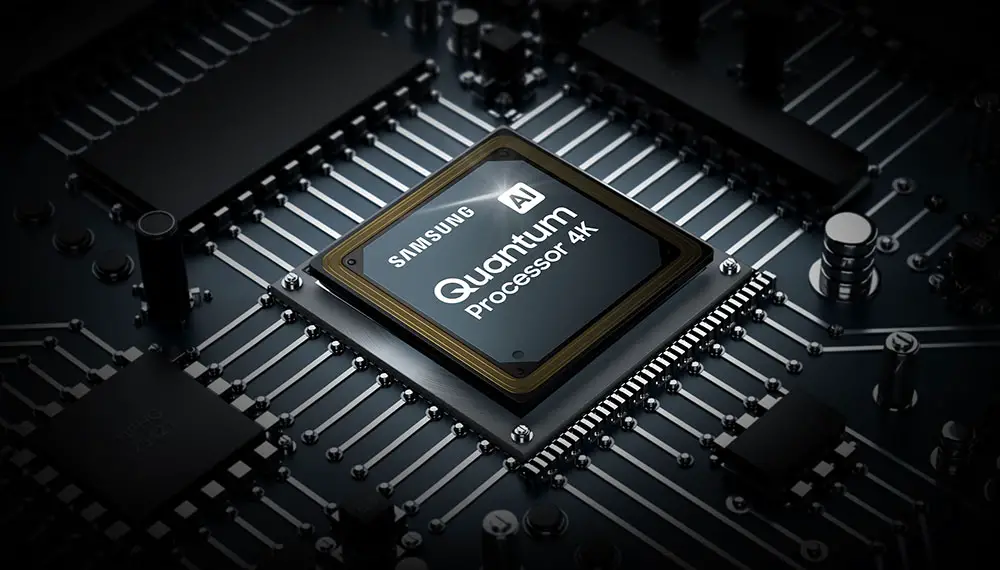
But the Quantum Processor 4K does not only bring image processing to the table but also includes a few audio enhancements including Adaptive Sound and Spatial Analysis along with Active Voice Amplifier (AVA). More on these technologies in our audio section.
Viewing angles
With viewing angles things are pretty obvious. This model along with the other Samsung TVs use a VA panel which offers very poor viewing angles. For this reason Samsung has used a special filter they call Ultra Viewing Angle in order to improve the end result. The Q80T managed to offer respectable image quality up to around 40 degrees from center position which is very good all things considered. Anything more and the image will start degrade very fast.

What this Ultra Viewing Angle technology does is to minimize the light leakage by focusing the light on the right direction and as a result we get wider viewing angles. A similar but less efficient technology called Wide Viewing Angle we saw in the Q70T. One thing we should note here is that the 49″ size does not have this special layer so viewing angles will be far worse while the European Q80T has to settle with the less efficient Wide Viewing Angle instead.
Brightness / Contrast
Let’s see now how the TV fairs in it’s brightness tests. As always we used the more accurate Movie mode with max brightness and high Local Dimming settings and in our SDR brightness over a 10% window we got a measurement of 702 nits which was excellent and more than you will ever need for SDR content. On the HDR brightness the 10% window gave us a measurement of 730 nits which is very good and can create some pretty impressive highlights.
The Q80T really managed to offer much better performance than what we saw in the Q70T. The FALD system seems to help with this also and in general the Q80T could pump enough brightness to make HDR justice and show how it is really meant to be seen. From these measurements we also got confirmation that the Q80T performs in the same league as the 2019 Q70R but with obvious better performance in the SDR brightness. With HDR content we can say that both units are more or less equals.
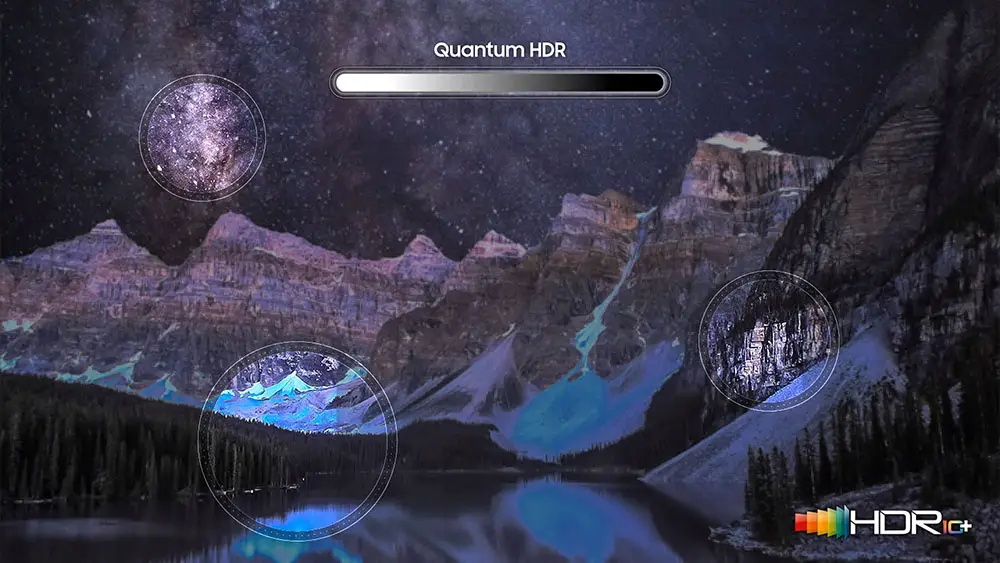
Now we should mention that for our testing we used a 55″ model. According to Samsung the 49″ size along with all the European models use Direct Full Array 8X instead of the Direct Full Array 12X we get here so this means that they probably use either a less capable FALD system or even less dimming zones and thus naturally perform worse than the measurements we got here. Keep this in mind when you do your comparisons.
As for it’s contrast the TV has good but not great. This is possibly a result of the Ultra Viewing Angle technology that is used in this one in order to improve the viewing angles that all VA panel equipped TVs suffer from. This has a side effect of reducing the contrast ratio a little. With the included Local Dimming feature black levels do improve but in general they still suffer from a slight grayish tone.
In general we can say that the Q80T is a huge improvement over the Q70T. The FALD system here makes a big difference while contrast ratio is good but not great. Performance of this TV is comparable to last year’s Q70R but with better brightness in SDR content.
HDR support
No surprises here actually. The Q80T supports the same set of HDR protocols as with all other Samsung TVs this year meaning that we get the basic HDR10 that is used for 4K UHD playback, the more advanced HDR10+ that was developed by Samsung to rival Dolby Vision that uses dynamic metadata for more accurate and higher quality images and HLG that is used for broadcasting.
With no Dolby Vision Samsung TVs have a major disadvantage but as HDR10+ now starts to become more widely available it’s still very early to determine what will become of this silly and unnecessary HDR format war. But one thing is for sure that with Samsung firmly behind the HDR10+ bandwagon don’t expect to see Dolby Vision in their TVs any time soon.
Motion performance – Samsung 85-inch class QLED Q80T series review
Let’s move on to our motion performance tests now. The Q80T comes with a 120Hz panel and with a backlight dimming frequency of 960Hz which basically seems to be the same as the Q70R. With such a high frequency flickering is not visible at all but obviously this depends on the picture mode that you choose as some of them will drop the frequency to 120Hz making some slight flickering visible.
Motion interpolation couldn’t be missing and the Q80T does a very good job at removing motion blur and judder. By enabling the Picture Clarity setting in the menu you can adjust the two available sliders for blur and judder according to your preferences. Too much of these and the “Soap Opera Effect” will show it’s ugly face but with very small settings you can get very nice and smooth results.
Black Frame Insertion (BFI) has become a standard lately and the Q80T also uses it by enabling the LED Clear Motion option setting. BFI is basically inserting a black frame in between two individual frames and this can result in smoother motion. But with BFI enabled flickering with further dive to 60Hz which can make flickering become very obvious while brightness is also lower due to the included black frames.
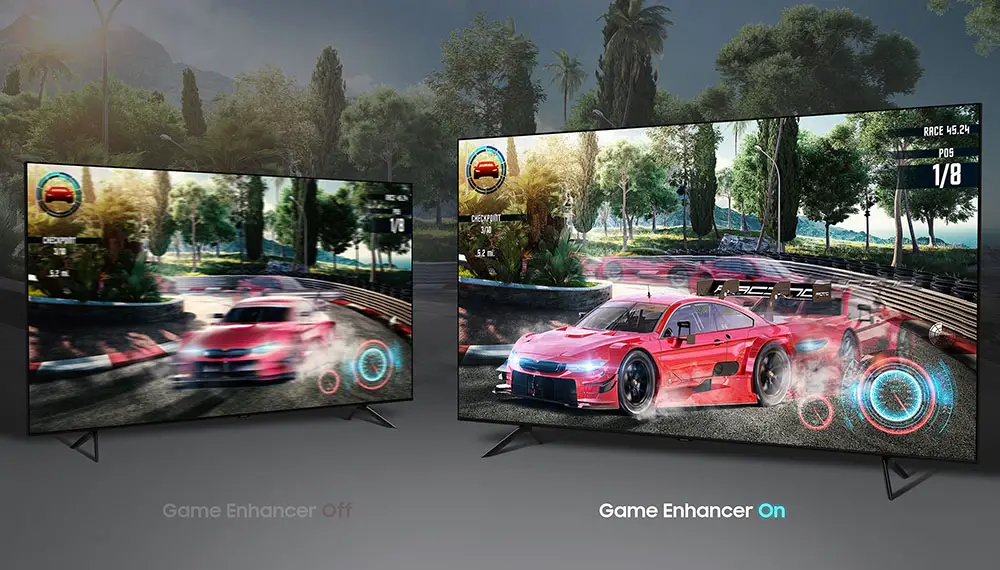
In general the Q80T did an excellent job with Motion Interpolation as there were very few artifacts visible and getting very good scores by us because of this. Lastly we should not forget to mention support for both FreeSync and HDMI Forum Variable Refresh RATE (VRR) which can work in case you connected another device that supports any of these two.
Color coverage
The Q80T is using what is known as Quantum Dot technology that is used by all Samsung’s QLED models and is responsible for displaying better and more vibrant colors. This technology is basically a special layer that is used on the panel and with it’s nano-sized Quantum Dots, that are finely tuned particles, they turn light into the billion plus colors you see on screen.
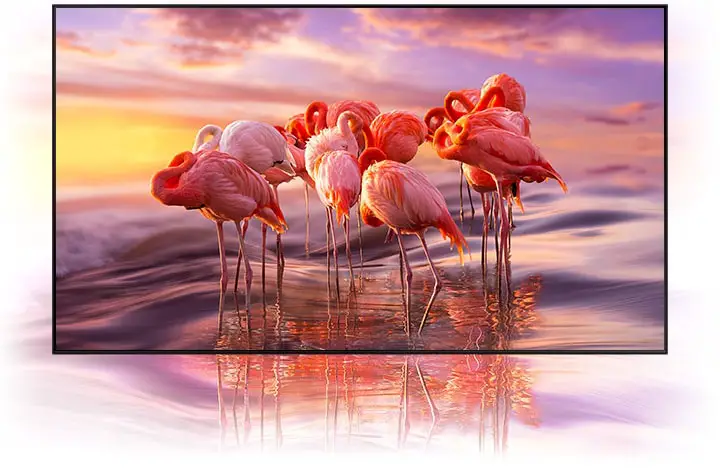
The Q80T managed to cover a 90% of the DCI-P3 color space which is great while on the wider REC.2020 it gave us a coverage that averaged at 70% which is also very good. These numbers indicate slightly better performance than the Q70T and similar to last year’s Q70R which is another strong indication that the Q80T should be more compared to the Q70R and not the Q80R from last year.
We are very pleased with the color coverage we got here as with the TV supporting Wide Color Gamut you will be able to get vibrant and lifelike colors as well as very good color gradients.
Input lag
We are used to get very low input lag measurements from Samsung lately so we had high hopes for the Q80T also. And we didn’t get disappointed as with Game mode enabled we got approximately 10.2ms of input lag which is amazing and can satisfy even the most serious of gamers. This is an average of both 4K and 1080p resolutions but the difference between the two is extremely small to be noticeable.
Without Game mode on, input lag went as high as 74.7ms so keep that in mind when using different Picture modes for different content. There is also Auto Low Latency Mode support (ALLM) and both PS4 and Xbox can benefit from it as both consoles support this feature.
For a real world testing we used F1 2019 through our PS4 and went on a few laps around in our Ferrari F1 to get a sense of response we would get from the TV. In one word, amazing. Every response, every reaction and every movement registered immediately on screen. There were no delays or lagging and we had a gaming session that was more smooth than ever. If you want a good quality TV but also like to have amazing gaming sessions the Q80T is one heck of a TV for it.
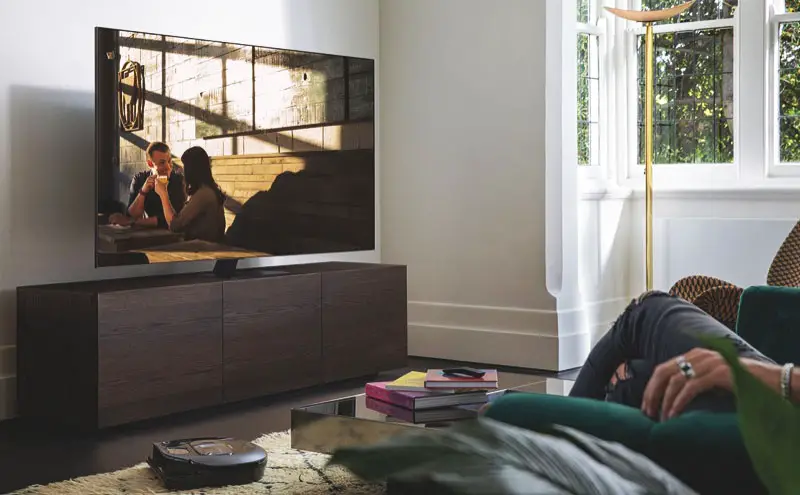
Image quality impressions
As we were expecting when we did our Q70T review, the Q80T here today gave us the kind of performance that very much resembled what we saw in last year’s Q70R. Both of them feature similar FALD systems with very close brightness measurements although the Q80T managed to fare much better in the SDR brightness. Also color reproduction and coverage was great while viewing angles were much better than the average VA panel due to the inclusion of the Ultra Viewing Angle technology.
Having the amazing Quantum Processor 4K means that we got amazing 4K images while the processor’s AI capabilities offered amazing upscaling along with other image and audio improvements. Lastly motion performance was very good and we got very smooth motion with very little visible artifacts overall.
The Q80T did manage to give us very good results overall and they were a very respectable upgrade from what we got in the Q70T. If you want to get good quality but you are also concerned about the price the Q80T provides the best balance between the two and we are sure that many will turn towards this model for their viewing pleasure.
Audio Quality
There’s more to the Q80T’s audio system than first meets the ear.
Samsung describes the set’s speaker configuration as 2.2.2, because in addition to downward firing stereo drivers and woofers, the set features additional speakers on the top left and right rear; these are all but invisible save for two small vents.
The additional drivers allow the TV to create a soundstage with exaggerated sonic height. This expanded speaker array works with OTS (Object Tracking Sound) technology, which cleverly steers sounds around to match movements. It’s not 3D audio, because as you listen the sound is still very much anchored to one central point, but the sonic result is bigger and more involving sound than the usual down-firing television noise.
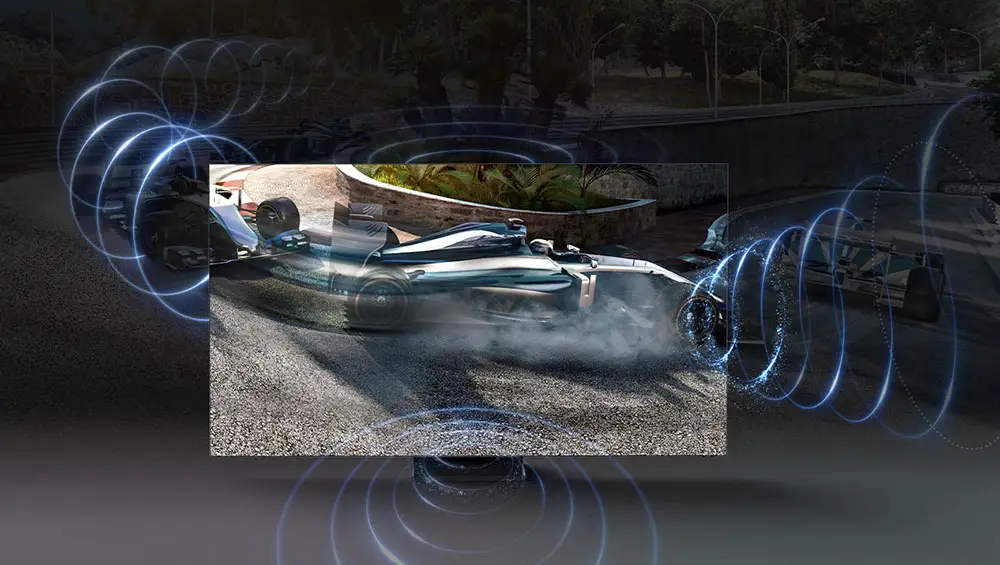
The system reveals extra sonic detail. Explosions throw their weight wider; dialogue seems more fully formed, no longer muffled beneath the screen. This isn’t high-fidelity, and it’s not comparable to what we’ve heard Bowers & Wilkins execute on some Philips OLED TVs, but it is a step up from the norm. Samsung rates the total audio output at 60W, more than enough welly to startle the cat.
Of course, there are limits though to what those onboard drivers can achieve. There’s no bass output below 100Hz.
If you want cinematic Dolby Atmos you can always bitstream out from the set over HDMI to a waiting soundbar or home cinema system.
Ports and Connectivity
When it comes to it’s connectivity options the Q80T utilizes exactly the same ports layout we saw in the Q70T also. As mentioned before all ports are located on the left side of the back panel, placed inside a special inset that can help with wall mounting as all of them face sideways and only the power connector is placed on the right side.
From top to bottom we get two USB ports, a digital optical audio output, four HDMI ports, an Ethernet port for wired connection to the internet, an Ex-Link mini jack along with the usual antenna port or ports depending on which country you get it.
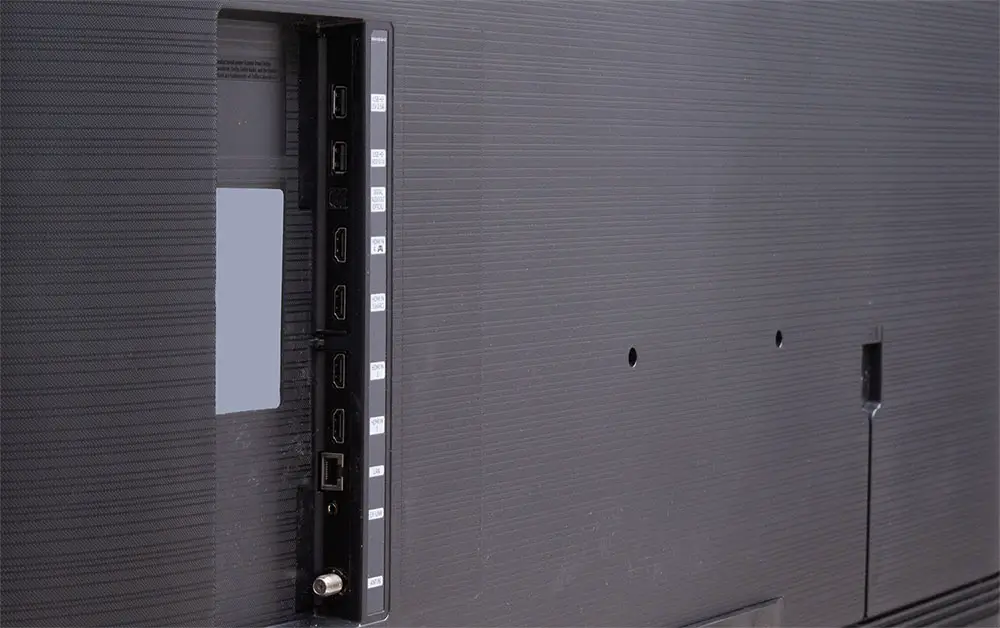
As we said in our Q70T the single most important feature here is the inclusion of the HDMI 2.1 in position 4 and all the new features that this new port brings with it. It’s good to see that Samsung decided to include HDMI 2.1 in their 4K QLEDs also (except for the Q60T) because their main rival LG is already utilizing these ports into their models and thus would make Samsung being left behind in this race. But except from HDMI 2.1 we also get eARC in HDMI 3 which many new devices start to use so it’s good to have it included in this TV also. On another note the USB ports are the older 2.0 instead of the faster 3.0 and this is a minus in our books.
As far as wireless connectivity the Q80T comes with built-in WiFi (802.11ac) along with Bluetooth v4.2 for wireless streaming from other mobile devices.
OS, Apps and Features
The Q80T comes with the 2020 version of Samsung’s Tizen and things here are pretty much the same as we saw in the Q70T and Q60T so this part of our review will be almost the same as in the other models. In 2020 Samsung made a few changes to their smart TV platform but nothing major as you could say most of these are basically improvements and small additions. The 2020 version comes with a dark UI which looks very different than the light white we were used in previous years. The change is mostly aesthetic so it’s a matter of taste if you like the new look or not.
General layout is the same as we get the launcher bar at the bottom of the screen along with a second row above it for making certain selections easier and faster including apps and additional content. And speaking of content with so much available, customization is a necessity and Tizen provides you with everything you need in order to re-arrange all icons in your own way. If you are using multiple services and apps you can place the ones you use the most at the beginning for easy access.

As for the streaming services included this wouldn’t be Tizen if there was no strong support for it. You can literally find everything you will ever want as all known names are included here. With Netflix, Apple TV, Disney Plus, Youtube, Amazon, Hulu, Rakuten, Demand 5 and BBC iPlayer being among the many more available you will certainly find the one you are looking for. As for Netflix and Amazon both of them support 4K and HDR. Navigation could not be any smoother as every command from the remote was registering immediately on screen without any visible delays or lagging.
Having so much content can be hard to handle especially if you are using many of these streaming services in general. For this reason Samsung has created the “Universal Guide” which is a very handy Tizen feature that is responsible for creating a ‘For You’ page that includes content you might be interested in watching based on your viewing habits. If you are are watching specific series for example the TV will analyze your viewing habits and give you suggestions which can be a real time saving feature.
There are also a few features that were included the last few years and one of them is SmartThings integration. With this you can use your TV to control other smart devices in your house like lights, door locks, thermostats and shades that also support SmartThings and make the Q80T your central smart hub of your house.

But for this to work on a TV you really need voice control functionality and the Q80T comes with support for all the most known ones. First of all there is Samsung’s Bixby but even if you don’t like Samsung’s offering you get support for both Amazon Alexa and Google Assistant. But voice control does not end there as with the TV’s support for Apple’s Airplay you can use Siri to issue your commands. Plenty of options to choose from in this regard.
One feature that has updated from last year is Multi-View. Basically the name is new but in a way this is an updated version of screen mirroring that we have in TVs for many years now. What this does is that now instead of simply mirroring your mobile device screen on the TV you can get a split screen where you can see both the TV and the mobile’s screen at the same time. Although it’s a nice gimmick to have we still haven’t found a practical way to use it but anyway, the more we get the better.
Last but not least we find the enhanced version of Ambient Mode now called Ambient Mode+. With this feature you can turn your TV from a black spot on your wall to a work of art as it can display various images and designs when you don’t use the TV in order to blend it to the environment. But with this improved version you can also display various other information including weather updates, news headlines, photos and music.
What can be said about Tizen that has not been said already. It’s an amazing platform and Samsung continues to add various, even small, improvements every year making it better and better. Some of these new features are not something major but anything new we get is always good to an already excellent smart TV platform.
